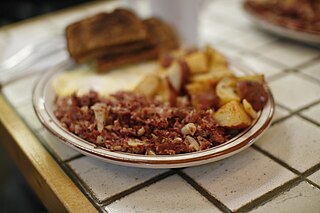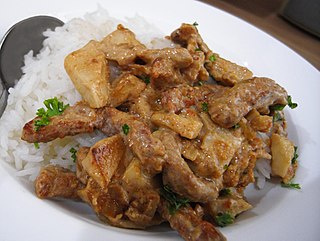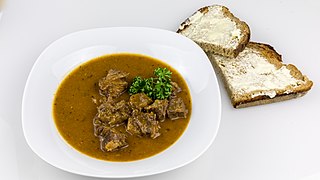
Cajun cuisine, is a style of cooking named for the French-speaking Acadian people deported by the British from Acadia in Canada, incorporating West African, French and Spanish cooking techniques, in region of Louisiana. Cajun cuisine is sometimes referred to as a 'rustic cuisine', meaning that it is based on locally available ingredients and preparation is relatively simple.

In cooking, a sauce is a liquid, cream, or semi-solid food, served on or used in preparing other foods. Most sauces are not normally consumed by themselves; they add flavor, moisture, and visual appeal to a dish. Sauce is a French word taken from the Latin salsa, meaning salted. Possibly the oldest recorded European sauce is garum, the fish sauce used by the Ancient Romans; while doubanjiang, the Chinese soy bean paste is mentioned in Rites of Zhou in the 3rd century BC.

Louisiana Creole cuisine is a style of cooking originating in Louisiana, United States, which blends West African, French, Spanish, Amerindian influences, as well as influences from the general cuisine of the Southern United States.

Tripe is a type of edible lining from the stomachs of various farm animals. Most tripe is from cattle and sheep.

A mirepoix is a flavor base made from cooked, diced vegetables, usually with butter, oil, or other fat, for a long time on a low heat without coloring or browning, as further cooking, often with the addition of tomato purée, creates a darkened brown mixture called pinçage. It is not sautéed or otherwise hard cooked, because the intention is to sweeten the ingredients rather than caramelize them. It is a long-standing cooking technique in French cuisine.

Hash is a culinary dish consisting of chopped meat, potatoes, and onions fried. The name is derived from French: hacher, meaning "to chop". It originated as a way to use up leftovers. By the 1860s, a cheap restaurant was called a "hash house" or "hashery."

Chateaubriand is a dish that traditionally consists of a large center cut fillet of tenderloin grilled between two lesser pieces of meat that are discarded after cooking. While the term originally referred to the preparation of the dish, Auguste Escoffier named the specific center cut of the tenderloin the Chateaubriand.
Green sauce or greensauce is a family of cold, uncooked sauces based on chopped herbs, including the Spanish and Italian salsa verde, the French sauce verte, the German Grüne Soße or Frankfurter Grie Soß, the British mint sauce and greensauce, and the Argentinian chimichurri.

Beef Stroganoff or beef Stroganov is a Russian dish of sautéed pieces of beef served in a sauce with smetana. From its origins in mid-19th-century Russia, it has become popular around the world, with considerable variation from the original recipe.

Rémoulade is a French cold sauce based on mayonnaise. Although similar to tartar sauce, it is often more yellowish, sometimes flavored with curry, and sometimes contains chopped pickles or piccalilli. It can also contain horseradish, paprika, anchovies, capers and a host of other items. While its original purpose was possibly for serving with meats, it is now more often used as a condiment or dipping sauce, primarily for sole, plaice, and seafood cakes.

A velouté sauce is a savoury sauce, made from a roux and a light stock. It is one of the five "mother sauces" of French cuisine listed by Auguste Escoffier in the 19th century, along with espagnole, tomato, béchamel and hollandaise. The term velouté is the French word for velvety.

Hayashi rice or Hashed beef rice (ハヤシライス) is a dish popular in Japan as a Western-style dish or yōshoku. It usually contains beef, onions, and button mushrooms, in a thick demi-glace sauce which often contains red wine and tomato sauce. This sauce is served atop or alongside steamed rice. The sauce is sometimes topped with a drizzle of fresh cream.

Meunière refers to both a sauce and a method of preparation, primarily for fish. The word itself means "miller's wife". Thus to cook something à la meunière was to cook it by first dredging it in flour. A meunière sauce is a simple preparation—brown butter, chopped parsley, and lemon—and the name refers to its unelaborate rustic nature.
Pompano en Papillote is a dish created by Jules Alciatore at Antoine's Restaurant in New Orleans for a banquet honoring the Brazilian balloonist Alberto Santos-Dumont. The dish was based in turn on a dish that Jules's father Antoine Alciatore had created—Pompano Montgolfier--honoring the brothers who had created the first balloons. A filet of pompano is baked in a sealed parchment paper envelope with a white sauce of wine, shrimp, and crabmeat. With a bit of luck the steam will puff up the parchment a bit, suggesting a hot air balloon.

Persillade is a sauce or seasoning mixture of parsley chopped together with seasonings including garlic, herbs, oil, and vinegar.

Oxtail soup is made with beef tails. The use of the word "ox" in this context is a legacy of nomenclature; no specialized stock of beef animals are used and tails may come from bovines other than oxen. It is believed by some that oxtail soup was invented in Spitalfields in London in the seventeenth century by French Huguenot and Flemish immigrants, from the tails of animals. Different versions of oxtail soup exist: Korean, Chinese, a fried/barbecued oxtail combined with soup variation which is a popular dish in Indonesia where it is called as sop buntut. An ethnic dish of the American South which traces its lineage back to the pre-revolutionary war era, and a thick, rich, gravy-like soup popular in the United Kingdom since the 18th century. Creole oxtail soup is made from a tomato base with oxtails, potatoes, green beans, corn, mirepoix, garlic, and herbs and spices.

Tunisian cuisine, the cuisine of Tunisia, is a blend of Mediterranean and Berber cuisines. Its distinctive spiciness comes from the many civilizations which have ruled the land now known as Tunisia: Romans, Vandals, Byzantines, Arabs, Spanish, Turkish, Italians (Sicilians), French, and the native Punics-Berber people. Many of the cooking styles and utensils began to take shape when the ancient tribes were nomads. Nomadic people were limited in their cooking implements by what pots and pans they could carry with them. The Tunisian tagine, is very different from the Algerian or Moroccan dish. It is a type of a pie dish, made out of eggs, meat and vegetables, similar to the Italian frittata or the eggah.

Wine sauce is a culinary sauce prepared with wine as a primary ingredient, heated and mixed with stock, butter, herbs, spices, onions, garlic and other ingredients. Several types of wines may be used, including red wine, white wine and port wine. Some versions are prepared using a reduction. Several types of wine sauces exist, and it is used in many dishes, including those prepared with seafood, poultry and beef. Wine sauces are associated with French cuisine.

A stew is a combination of solid food ingredients that have been cooked in liquid and served in the resultant gravy. Ingredients in a stew can include any combination of vegetables and may include meat, especially tougher meats suitable for slow-cooking, such as beef, poultry, sausages, and seafood. While water can be used as the stew-cooking liquid, stock is also common. Seasoning and flavourings may also be added. Stews are typically cooked at a relatively low temperature, allowing flavours to mingle.

















